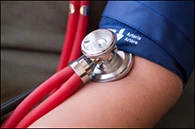Diagnostic Guidelines for Blood Pressure Screening Techniques
COURSE NUMBER: 490
Credit Hours:
1 Hour(s)
SHARE
About one-third of American adults have high blood pressure. Many patients see a dentist more frequently than a physician, providing the dental team an opportunity to educate their patients about blood pressure readings and how it affects ...
(Use this feature to create assignments for your students and staff.)
Overview
About one-third of American adults have high blood pressure. Many patients see a dentist more frequently than a physician, providing the dental team an opportunity to educate their patients about blood pressure readings and how it affects their overall health. The information in this course teaches the dental professional to be aware of the causes and how to determine and assess identifiable causes of hypertension as well as providing the appropriate method of taking a blood pressure and how to determine the recommendations for follow-up and lifestyle modifications for patient treatment.
In a survey conducted by Malamed of over 2,700 dentists in North America, it was reported approximately 14,000 potentially life-threatening emergencies occurred while patients were in their dental practice. High blood pressure is linked to risk factors that fall into two categories: risk factors that are outside the patient’s control, such as family history, age, gender, and race and risk factors that the patient can control, such as lack of physical activity, unhealthy diet, overweight or obese, and drinking too much alcohol. Tobacco use, stress, and sleep apnea are additional risk factors that contribute to high blood pressure, but are still being researched on their correlation to high blood pressure.
Taking patients’ blood pressure during dental examinations is critical to their overall health. High blood pressure is a proven risk factor for cardiovascular disease, heart failure, stroke, and renal (kidney) disease. A baseline blood pressure reading should be established and then monitored at future dental appointments by allied dental staff. The patient should be told what their blood pressure reading is each time so that they can keep track of differences themselves. Blood pressure readings might need to be taken a few times to reflect a more accurate reading for diagnoses and when referring to medical professionals. Factors that may affect the accuracy of blood pressure readings include caffeine, recent physical activity, smoking, and stress to name a few. Screening for blood pressure by the dental professional has proven to be extremely effective since many patients with hypertension may be unaware of their condition. Establishing a baseline reading for your patient in a non-stress producing environment produces a more accurate reading if you need to make a medical referral. Screening for blood pressure by the dental professional has proven to be extremely effective since many patients with hypertension may be unaware of their condition.
Intended Audience:
Dental Assistants, Dental Hygiene Students, Dental Hygienists, Dental Students, Dentists, Dental Assisting Students
Date Course Online:
Nov 30, 2015
Last Revision Date:
Dec 31, 2000
Course Expiration Date:
Nov 29, 2018
Cost:
Free
Method:
Self-instructional
AGD Subject Code(s):
Learning Objectives
Upon completion of this course, the dental professional should be able to:
Recognize causes of hypertension.Determine how to assess identifiable causes of hypertension.Explain the terms systolic, diastolic, and pulse pressures.Identify the various blood pressure categories.List factors that influence blood pressure.Explain the equipment needed to determine blood pressure.Demonstrate how to take blood pressure.Discuss follow-up recommendations for patient treatment.Explain lifestyle modification recommendations.
Disclaimers
Participants must always be aware of the hazards of using limited knowledge in integrating new techniques or procedures into their practice. Only sound evidence-based dentistry should be used in patient therapy. Note: Registration is required to take test.
Submission Information
Recognition
Approved PACE Program Provider
THE PROCTER & GAMBLE COMPANY
Nationally Approved PACE Program Provider for FAGD/MAGD credit.
Approval does not imply acceptance by any regulatory authority or AGD endorsement.
8/1/2021 to 7/31/2027
Provider ID# 211886
(Use this feature to create assignments for your students and staff.)



